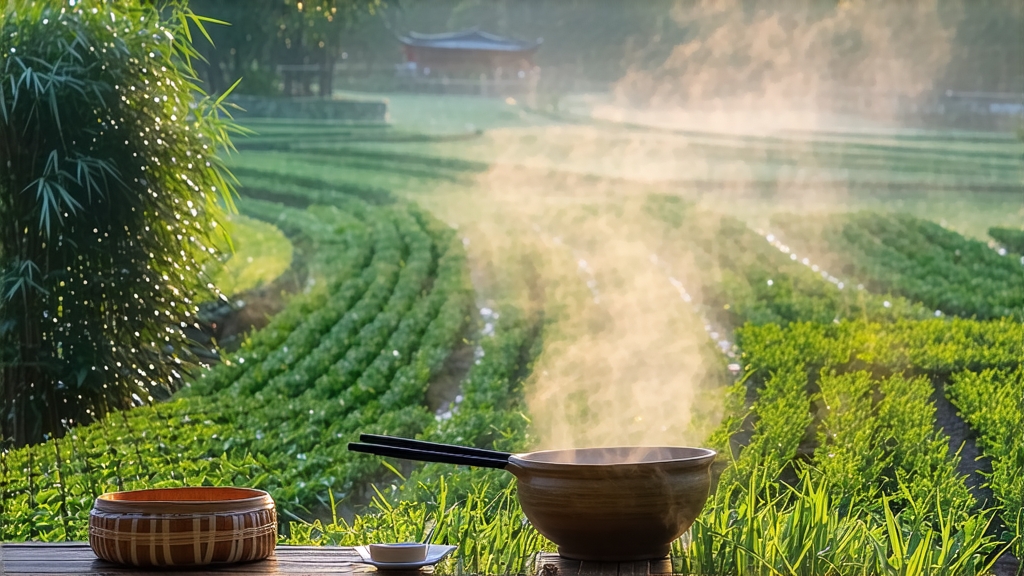
Longjing, literally “Dragon-Well,” is the most celebrated among China’s more than one thousand green-tea styles. Its fame rests not on legend alone but on a convergence of soil, micro-climate, cultivar, and human skill that has been refined for well over a millennium. To understand why a single sip can taste like sweet spring water, fresh snow peas, and roasted chestnuts all at once, one must follow the leaf from Tang-dynasty monastic gardens to the modern auction block, from the misty hills of Hangzhou to the porcelain gaiwan on your table.
History: From Temple to Imperial Tribute
Buddhist monks planted the first tea bushes on the shale-rich slopes surrounding West Lake during the eighth century. By the Song dynasty the leaves were already bartered for ink and silk; by Ming times local magistrates were sealing the best lots in yellow silk and dispatching them to Beijing as tribute. The Qianlong Emperor’s 1751 visit enshrined the tea in folklore: legend claims he pocketed a handful of buds, which later sprouted beside a stone well shaped like a crouching dragon—hence the name. Whether myth or marketing, the story cemented Longjing’s identity as the emperor’s tea, a status it never relinquished.
Terroir: Why West Lake Matters
Hangzhou sits at 30°N, the same latitude as Morocco’s cedar forests and Florida’s citrus belt, yet its climate is moderated by the 6,500-hectare lake and by the Qiantang River delta. Winter frost is brief; spring arrives early, often in late February. The shale-derived soil is porous, forcing roots to dive deep for minerals while draining excess water that could dilute flavor. Diurnal swings of 8–10 °C slow overnight respiration, locking in amino acids—especially L-theanine—that translate into brothy sweetness. Within the protected West Lake Geographic Indication (GI) zone, the micro-parcels of Shi-feng, Mei-jia-wu, Weng-jia-shan, Long-wu, and Hu-pao each confer subtle differences: Shi-feng yields the most aromatic, almost orchid-like cups; Hu-pao adds a flinty minerality reminiscent of wet stones.
Cultivars: Beyond the Generic “Longjing”
Most outsiders assume Longjing is a single plant; in reality it is a stylistic umbrella. The traditional cultivar is Qun-ti-zhong, a seed-propagated landrace with small, thick leaves and low yield but unparalleled complexity. Since the 1980s clonal selections have spread: Longjing #43 ripens five days earlier and produces a prettier, uniformly spear-shaped leaf, while the frost-resistant Zhong-tea 108 trades some fragrance for higher yield. Purists insist on Qun-ti-zhong for its lingering “sweet throat,” yet most commercial lots are blends. Knowing the cultivar is the first step toward predicting cup character: #43 tends toward bright asparagus and sweet corn; Qun-ti-zhong leans into fennel and white sesame.
Craft: The 250-Second Dance in a 200 °C Wok
Longjing belongs to the pan-fired family of green teas, yet its choreography is unique. Picking begins when the spring bud reaches the “sparrow’s tongue” stage—one unfolded leaf embracing a tiny tip. The standard is 2.5 cm length, 0.5 g weight; it takes 60,000 such shoots to make one kilogram. Within four hours of plucking the leaves are spread 3 cm thick on bamboo trays to lose surface moisture; this withering reduces grassy harshness. The critical kill-green step uses a bare, cast-iron wok seasoned with tea oil. A master—often a woman who has apprenticed since adolescence—keeps the surface at 180–200 °C, flicking 250 g of leaves in ten-gram arcs. Her palms alone judge temperature; when the metal becomes too hot she smears a dab of tea-oil soaked cloth, creating the micro-layers of toastiness that later emerge as chestnut aroma. The sequence follows ten beats: grab, press, rub, fling, shake, roll, buckle, straighten, toss, release. After 90 seconds the leaves are stiff enough to exit, yet supple enough to be shaped. Temperature drops to 80 °C for the “hui-guo” return wok: